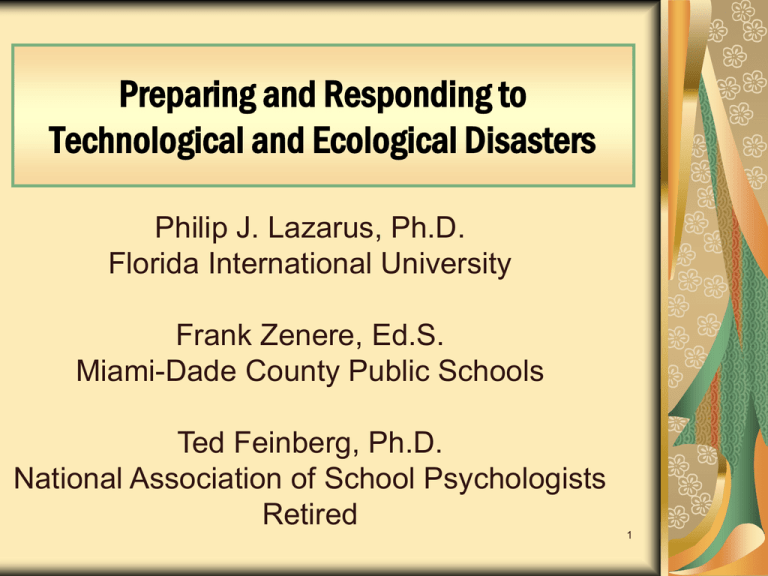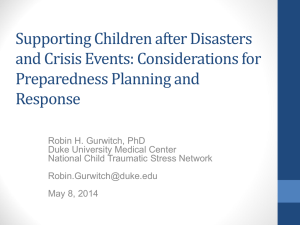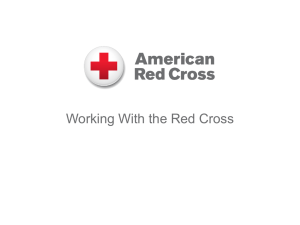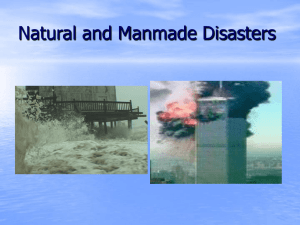tech_ecol_dis
advertisement

Preparing and Responding to Technological and Ecological Disasters Philip J. Lazarus, Ph.D. Florida International University Frank Zenere, Ed.S. Miami-Dade County Public Schools Ted Feinberg, Ph.D. National Association of School Psychologists Retired 1 Gulf of Mexico Oil Spill 2010 2 WHAT HAPPENS Crisis and trauma throw people so far out of their range of balance that it is difficult to quickly restore equilibrium. Crisis reactions may be precipitated by either “acute or chronic” stress. Acute stress is caused by sudden, arbitrary and often random event. Chronic stress occurs repeatedly over time with each recurrence further challenging a person’s adaptive resources. 3 THE CRISIS RESPONSE: THE SHORT-TERM CRISIS REACTION The normal human response to trauma follows a similar pattern called the crisis reaction; It occurs across gender, ethnicity, age and culture. 4 THE PHYSICAL RESPONSE Exhaustion Physical arousal associated with the “fight or flight” syndrome cannot be prolonged indefinitely and results in physical exhaustion. Chronically high anxiety levels can lead to feeling “burned out” Caregiver Reaction Production of chemical “oxytocin”, primarily in women, may produce a “Tend and Befriend” reaction as an effort to protect children or loved ones. 5 THE EMOTIONAL REACTION Our emotional reactions are heightened by our physical response Stage 1: Shock, disbelief and denial Stage 2: Cataclysm of emotions including anger/rage, fear/terror, sorrow/grief, confusion/frustration, self blame/guilt Stage 3: Reconstruction of equilibrium – the emotional roller coaster that seeks balance 6 KEY CONCEPTS OF DISASTER MENTAL HEALTH No one who sees a disaster is untouched by it. There are two types of disaster trauma (a) individual and (b) collective. Most people pull together and function during and after a disaster but their effectiveness is diminished. Disaster can bring people together, enhancing community cohesion, solidarity, and unity. Disaster stress and grief reactions are normal responses to an abnormal situation. 7 KEY CONCEPTS OF DISASTER MENTAL HEALTH Many emotional reactions of disaster victims stem from problems of living caused by the disaster. Disaster relief procedures have been called “The Second Disaster.” Most people do not see themselves as needing mental health services following disaster, and will not seek out such services. 8 KEY CONCEPTS OF DISASTER MENTAL HEALTH Individuals may reject disaster assistance of all types. Disaster mental health assistance is often more “practical” than “psychological” in nature. Disaster mental health services must be uniquely tailored to the communities they serve. 9 KEY CONCEPTS OF DISASTER MENTAL HEALTH Mental health staff need to set aside traditional methods, avoid the use of mental health labels, and use an active outreach approach to intervene successfully in disaster. Survivors respond with active interest and concern. Sensitivity to cultural factors, unique regional characteristics, and individual differences 10 KEY CONCEPTS OF DISASTER MENTAL HEALTH Interventions must be appropriate to the phase of the disaster. Support systems are crucial to recovery. Minimize economic (e.g., occupational, income), physical (property, possessions), social (e.g., family, friends), personal (e.g., personal beliefs), psychological (e.g., identity), and emotional losses 11 THE EXXON-VALDEZ OIL SPILL 12 LESSONS LEARNED FROM THE EXXON-VALDEZ OIL SPILL On March 24, 1989, the supertanker Exxon Valdez ran aground on Bligh Reef in Prince William Sound, Alaska. Largest oil spill in North America. Approximately 42 million liters of oil was released into valuable commercial fishing grounds. 13 communities affected. Long term effects: Ecological effects for a decade or more. The disaster is just the beginning of a cascading set of challenges and stressors. 13 THE EXXON-VALDEZ OIL SPILL: AFTERMATH Greater exposure to the spill was associated with greater disruptions in psychosocial functioning The "dose-response" relationship: The greater the dose (exposure to the spill) the greater the negative effects One-year post spill: 20% had generalized anxiety disorder 9% had post-traumatic stress disorder 17% had major depression disorder Alaskan Natives displayed elevated risk for experiencing psychosocial problems 14 THE EXXON-VALDEZ OIL SPILL: AFTERMATH One year post-spill: Declines in social relationships with friends, neighbors, coworkers Increases in drug and alcohol abuse Increases in domestic violence Increases in physical health problems Family support buffered the effects of the spill on psychosocial functioning 15 THE EXXON-VALDEZ OIL SPILL: AFTERMATH Fishing communities were hit the hardest Loss of revenue totaled $155 million Total collapse of local herring and salmon fishing industry The “income loss spiral” Greater losses (e.g., discretionary income, employment, having to sell possessions) were associated with disruptions in psychosocial functioning 16 THE EXXON-VALDEZ OIL SPILL: AFTERMATH Long-term effects on fishing communities: 6-years post spill: 23% of men and 13% of women had clinically significant anxiety 39% of men and 20% of men had depression 34% of male fishers and 40% of female fishers had a high number of PTSD symptoms 17 HEALTH EFFECTS OF OIL CONTAMINATION Acute symptoms: Skin irritation, itchy eyes, scratchy throat, headaches, dizziness, chronic pain, nausea, respiratory problems Increases in genotoxicity (i.e., cell poisoning) Associated with higher cancer rates Endocrine problems Alterations in hormone levels Blood toxicity 18 19 20 21 DIFFERENCES BETWEEN TECHNOLOGICAL/ECOLOGICAL AND NATURAL DISASTERS Lighting a fire vs. heating up an oven Trauma associated with natural disasters is more acute but effects generally dissipate more quickly Trauma associated with technological/ecological disasters is less acute but effects may exist for decades Technological/ecological disasters have a longterm “corrosive” effect on communities 22 DIFFERENCES BETWEEN TECHNOLOGICAL/ECOLOGICAL AND NATURAL DISASTERS People can struggle over whom to blame for causing a technological/ecological disaster Cleanup and relief efforts often are hampered by slow legislation and litigation—extends the recovery period for victims Victims often become suspicious and cynical Authorities and community leaders often are blamed, scapegoated, or criticized for being unresponsive 23 DIFFERENCES BETWEEN TECHNOLOGICAL/ECOLOGICAL AND NATURAL DISASTERS Instead of volunteering to help with recovery efforts, people may expect companies to do all the work This slows down the recovery Disaster response is not lucrative for “guilty” companies Similarly, people may not donate needed funds or resources because they believe the company should pay 24 TRAUMA AND LOSS Trauma is accompanied by a multitude of losses Loss of control over one’s life Loss of faith in one’s religious/spiritual belief system Loss of trust in other people Loss of worldview – of fairness and justice 25 CONSERVATION OF RESOURCES Any event resulting in an actual or perceived loss of resources, or a lack of expected resource gain, produces stress. These resources may include: Objects (boat, house, car) Personal characteristics (self-concept, selfesteem, identity) Relationships (marriage, friendships) Energies (credit, money, social capital) 26 CONSERVATION OF RESOURCES Resource loss is the strongest predictor of psychological distress following a disaster The more depleted resources become, the worse the adjustment Depletion across multiple domains is most problematic Depletion can be merely anticipated to cause significant stress 27 RESOURCE LOSS IN TECHNOLOGICAL/ECOLOGICAL DISASTERS Changes in work, having to sell possessions, income loss, and investment without gain (i.e., taking on additional work to avoid income loss) is associated with anxiety and depression Negative changes in relationships are associated with declines in physical health and depression 28 IMMEDIATE EFFECTS OF AN OIL SPILL Help with problem-solving and exploring other possibilities Assist with coordinating services to meet basic needs Adapted from Weber and Lord (2010) 29 COPING AFTER AN OIL SPILL Maladaptive coping is associated with anxiety, depression, and PTSD Avoidant coping is associated with the worst long-term (6 > years) distress Adaptive coping is protective, especially: Seeking social support Cognitive restructuring 30 EFFECTS OF DISASTERS ON CHILDREN 31 TRAUMA AND REGRESSION Trauma is often associated with regression to an earlier stage of development – mentally and physically Individuals may do things that later seem childish Examples include loss of humor, diminished impulse control, free floating irritation, assuming a fetal position, referring to authority figures such as parents, law enforcement or administrators as “mommy or daddy.” 32 TRAUMA AND REGRESSION Individuals may feel childish; Examples include: Feeling small Wanting someone to take care of them Feeling weak Feeling as if things are out of control as if one were a child again Using language that is highly simplified Withdrawing and seeking nurture Being afraid to sleep alone or of the dark 33 INFLUENCES ON CHILDREN’S REACTIONS TO DISASTERS Factors that influence children’s reactions include: Dislocation from home or community Level of parental support Pre-existing risks: previous traumatic experience or mental illness 34 TRAUMA REACTIONS: PRESCHOOL-AGE CHILDREN Simulate the spill in play Fear eating and drinking due to contamination concerns Anxiety and withdrawal General behavioral problems Regressive behaviors: Thumb sucking, bedwetting, clinging to parents Sleep disturbances Fear of dark Loss of appetite 35 TRAUMA REACTIONS: ELEMENTARY-AGE CHILDREN Extreme withdrawal Disruptive behavior Difficulty paying attention Outburst of anger, irritability, aggression Somatic complaints (stomach aches headaches) Anxiety and depression Emotional numbing Nightmares, sleep difficulties School avoidance Fears Of dark Of being left alone Of being separated from family That something bad will happen to family That they caused some part of the disaster That they failed to prevent some part of the disaster 36 TRAUMA REACTIONS: MIDDLE AND HIGH SCHOOL-AGE CHILDREN Sleeping and eating disturbances Agitation Irritability, anger, acting-out behavior Delinquency Physical complaints Poor concentration Depression and anxiety Withdrawal Conflict with caregivers and teachers 37 LONG-TERM CRISIS REACTIONS Not all victims of trauma/crisis suffer significantly from long-term stress reactions. Many victims may continue to be reminded or reexperience some degree of crisis reactions over a longer period of time. These crisis reactions are often associated with “trigger or kindling events”, environmental cues, that remind the person of the trauma. These cues can bring back the intense emotion and physical reactions of the original trauma. 38 LONG-TERM CRISIS REACTIONS Trigger Events vary with different victims/survivors but may include: Sensing (seeing, hearing, touching, smelling, tasting) something similar to what one was acutely aware of in the original incident Anniversaries of the event Proximity of holidays or significant “life events” to the trauma/crisis 39 STUDENTS WHO ARE AT HIGH RISK Had a high level of exposure Suffered significant loss Are grieving for victims Relocated following the disaster Had preexisting anxiety disorders or mental health problems Had inadequate parental support Are separated from their family Used inadequate coping mechanisms Experienced previous trauma 40 LONG-TERM CRISIS REACTIONS SUMMARY: Victims of trauma/crisis may experience stress reactions for years. Long-Term Stress Reactions are natural responses to terrible events. Unresolved stress reactions may result in several forms of post traumatic behavior. 41 RECOVERY FROM TRAUMA 42 RECOVERY FROM TRAUMA Many people live through trauma and are able to reconstruct their lives without additional help 20/60/20 Rule: About 20% of those experiencing trauma will adapt and return to normal functioning within a short period of time. About 60% will experience some type of stress reaction that will, for a period of time, impair functioning. About 20% will suffer extensive impairment in one or more of their life functions. 43 RECOVERY FROM TRAUMA Recovery from immediate trauma is often affected by the following factors: The severity of the incident and level of crisis reaction The ability to understand what happened The person’s pre-crisis stability The nature and breadth of one’s support system Access to help The degree to which one’s experience is validated by culture and others 44 RECOVERY FROM TRAUMA Recovery issues for victims include: The victim gaining some meaningful perception of control over the event Working out an understanding of the incident and, as needed, a redefinition of worldview and values Re-establishing a sense of future and personal goals Re-establishing a sense of meaning, integration of the event into a personal narrative The degree to which an individual can prevent the loss of important tangible objects, roles, attachments, and feelings of connectedness and intimacy 45 INFLUENCES ON RECOVERY FROM TRAUMA Family Faith Friends God Prayer Church Clergy Support Groups Peers Purpose 46 INFLUENCES ON RECOVERY FROM TRAUMA Teams and clubs Sports Siblings Activities/hobbies Music Art Writing/journals Pets Teachers Medical doctors Psychologists and counselors 47 INFLUENCES ON COPING Parent’s Reaction and Family Support: Parent’s adjustment is an important factor in children’s adjustment Relocation: Relocation is associated with higher levels of ecological distress, crowding, isolation, and social disruption Coping Style: Coping responses influence the process of adapting to traumatic events Using blame and anger as a way of coping may create more distress for children following disasters 48 HELPING CHILDREN AFTER DISASTER: RECOMMENDATIONS Meet and greet students Remain calm and reassuring Acknowledge and normalize feelings/reactions Encourage expression about disaster-related events Promote positive coping and problem-solving skills Emphasize children’s resiliency 49 HELPING CHILDREN AFTER DISASTER: RECOMMENDATIONS Establish/reinforce routines and expectations. Provide opportunities for children to share their concerns. Involve children in activities that allow them to make choices and resume a sense of control over their environment. Incorporate information about the disaster into related subject areas, as appropriate. 50 HELPING CHILDREN AFTER DISASTER: RECOMMENDATIONS Listen to and observe children’s behavior. Be sensitive to the disruption that relocation may cause. Consider the developmental level and unique experiences of each child. Involve students in recovery-related activities/projects. Identify children at risk and make a referral to the appropriate school or community-based resource. 51 HELPING CHILDREN AFTER DISASTER: RESPONSES TO QUESTIONS How do I respond to students when they ask, “Why did this happen?” How can I help students with their lessons? How do I assist students in understanding why some families experienced losses while others did not? How do I help students deal with anxieties about the future? 52 SUPPORTING STUDENTS AFTER DISASTERS: RECOMMENDATIONS FOR TEACHERS Communicate with families regularly Balance academics and social/emotional learning Focus on students’ strengths Help students become better problem solvers Make note of lessons learned 53 HELPING CHILDREN AFTER DISASTER: SUGGESTIONS FOR PARENTS Listen to your child’s concerns, anxieties and fears – validate their feelings. Offer realistic reassurances of safety and comfort. Provide structure and routine in the home environment. Encourage involvement in family and community recovery efforts. 54 HELPING CHILDREN AFTER DISASTER: SUGGESTIONS FOR PARENTS Be aware of abrupt changes in your child’s behavior; make appropriate professional contacts. Provide factual information and talk in hopeful terms regarding the future. Be prepared to tolerate regressive and acting out behaviors during the early post disaster phase. 55 PREPARING CHILDREN FOR NATURAL DISASTERS Educate children about potential threats or disasters in their community. Take children’s fears seriously. Provide important information about enhancing personal safety. Teach children specific precautions for each disaster. Explain to children when and how to seek help (i.e., 911). 56 KEYS TO RESILIENCE Caring and loving family/friends Ability to make/carry out realistic plans Positive view of self/skills Capacity to manage strong feelings/emotions Positive view of the future 57 RESILIENCE AND OIL SPILLS Shield children, families, and community members from exposure Undo harm caused by exposure Take action—become involved with local relief and recovery initiatives Promote environmentally friendly policies and actions Increases in eco-friendly beliefs, behavior, and policies often follow technological/ecological disasters 58 Contact Information For further information please contact Philip J. Lazarus, Ph.D. Associate Professor and Director School Psychology Training Program Florida International University Miami, Florida 33199 305-348-2725 philaz1@aol.com 59







